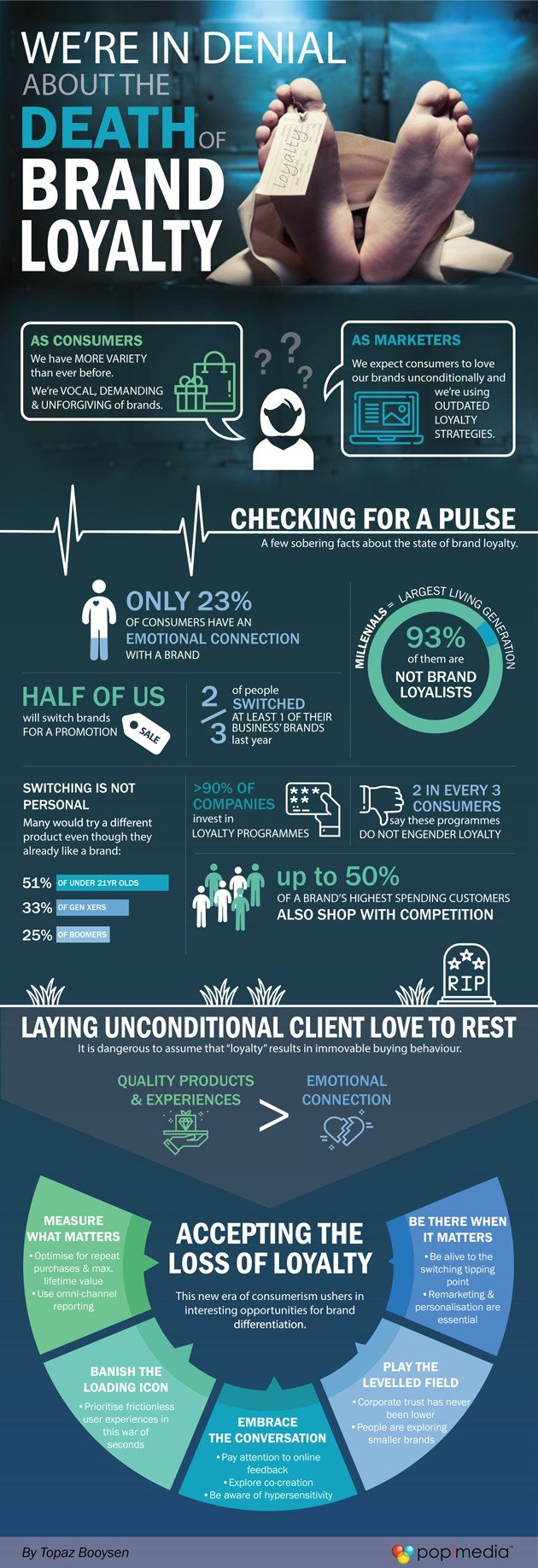#BizTrends2019: We're in denial about the death of loyalty

But all too often, once we close that shopping app and swivel back around to the meeting at hand, we still implement antiquated loyalty strategies into our marketing plans. They may have worked back when the telegram was far from ‘instant’, but now that everything has changed, so should our approach to connections with customers.
Checking for a pulse
As the disconnect between brands’ offerings and consumers’ expectations becomes more glaring each day, a fresh perspective can be found in taking stock of what really matters to people and our bottom lines.
A few sobering facts about the state of brand loyalty:
- Only 23% of consumers say they have an emotional connection with a brand, and this number continues to plummet.
- The largest living generation, millennials, are entering prime spending years, and only 7% of them identify themselves as brand loyalists.
- Consumers are more fickle than ever before. According to Accenture’s recent study, 61% of people have switched at least one of their business’ brands in the past year.
- Half of all consumers will gladly change brands for a promotion.
- Switching is not a personal thing for millennials. 51% of 18- to 21-year-olds said they would try out different products even though they already like a brand.
- Older generations are less adventurous: 67% of Gen Xers and 75% of baby boomers said that when they find a product they like they buy it over and over again.
- The vast majority of companies (more than 90%) actively invest in some form of loyalty programme. And while companies spend billions each year on these benefits, more than two-thirds of all consumers feel loyalty programmes do not engender loyalty.
- Lastly, a brand’s big spenders aren’t necessarily loyal. Up to 50% of a brand’s highest-spending customers also shop with its competitors.
Laying unconditional client love to rest
So where does this leave us, apart from mourning the customer satisfaction feedback and little blue stars we’ve always found so deeply gratifying?
The end goal has not changed: retention and maximised lifetime value is still the target. After all, increasing customer retention by just 5% can boost profits by 25% to 95%. The danger comes in assuming that “loyalty” results in immovable buying behaviour and that emotional connection trumps quality products and experiences.
The acceptance stage
While the post-mortem of loyalty may be morbid, this new era of consumerism ushers in interesting opportunities for brand differentiation.
Measure the behaviour that matters
While likes and followers are useful for awareness, when it comes to bottom-line results, optimising for the golden metrics of repeat purchases and lifetime value are key. Thanks to omnichannel analytics, we never have to be in the dark about the real worth of our clients again.
Embrace the conversation or tread lightly
Online consumer opinion is now as loud as the advert blasted at half-time, and brands that are paying attention are at an advantage. In fact, 57% of people break up with a brand when a negative review remains unaddressed. We also have unparalleled opportunities for co-creation, like allowing consumers to design the shoes they want. But tread lightly in our hyper-sensitive environment, as “going viral” is not always a good thing.
Banish the loading icon
We close a website when it takes 3 seconds to load, but expect our customers to complete lengthy registration each time they log in to our app. Brands who manage to eliminate user experience friction across all channels are fast becoming the only relevant options for consumers who are spoilt for choice in this war of seconds.
Enjoy the levelled playing field
As trust in corporates is at an all-time low and blind loyalty becomes a thing of the past, people are more open to exploring other options. This levels the playing field for smaller brands and subsequently means that substandard products will not last long.
Be there when it matters
Marketers need to be more alive to consumers’ tipping point: when the effort of switching no longer outweighs the convenience of staying with a brand. Remarketing and personalisation are imperative, and brands that are there when clients are most susceptible to switching will win out (like during a life change, when premiums increase, or when 82% of smartphone users research a product online while they’re in-store).
In the absence of loyalty’s safety net, we need to shake off any pretences about our brands and accept that consumers buy for value and convenience, not indelible emotions. After all, have we not all unashamedly switched from a brand recently to cash in on that discount?


























